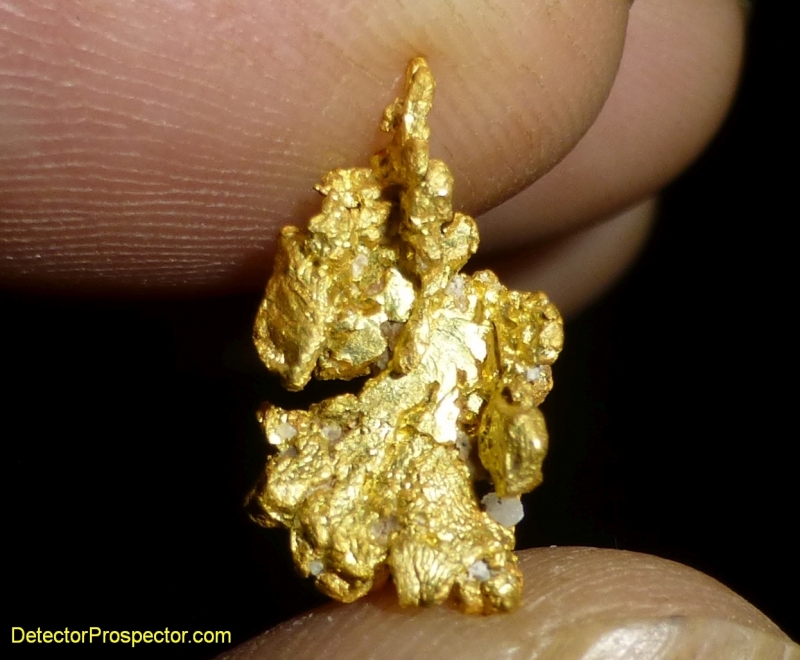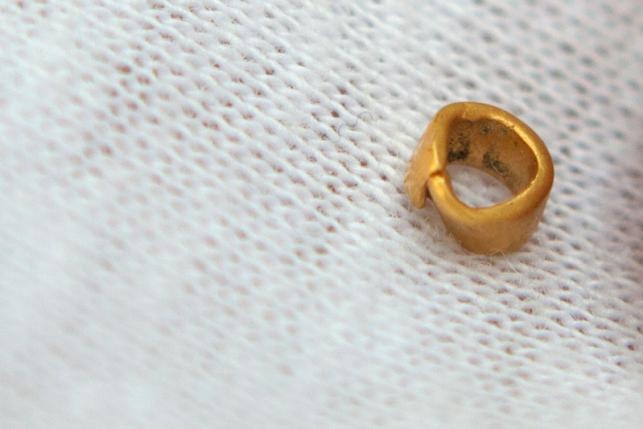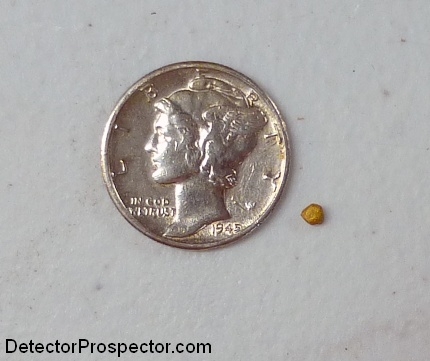-
Posts
19,805 -
Joined
Content Type
Forums
Detector Prospector Home
Detector Database
Downloads
Everything posted by Steve Herschbach
-
I am getting out now and then but have been pretty laid back this year compared to last, and my nugget finds are suffering for it. I am busy on other fun projects however so no complaining from me. Still, some gold has been coming my way. This one I like for the character so I figured a photo was a requirement. 2.33 grams or 1.5 pennyweight. There sure is some nice gold in California!
-

Minelab GPZ 19 Coil Release Update
Steve Herschbach replied to Steve Herschbach's topic in Minelab Metal Detectors
Minelab dropped the price of the GPZ dramatically at the end of February. This is to help reward early buyers who paid the original higher price for the GPZ by way of a special deal on the coil. -
Well, in answer to several comments above... My link was to nugget VDI numbers with a White's detector which uses a different scale than the Gold Racer. White's -95 to 0 is ferrous, 1 to 95 non-ferrous. Gold Racer under 40 is ferrous, above 40 non-ferrous. That is air tests, in ground non-ferrous items will get pulled into ferrous range with any VLF. I posted the link just to show there is no "gold" VDI number. The larger the nugget, the purer the nugget, the more solid the nugget - the higher the VDI number. In general metal detectors do not respond to fine gold in a bottle - Finally, pinpoint modes are not generally needed to pinpoint targets. The target is where the beep is. However, if you are in disc mode by going to pinpoint you are just temporarily entering a no-motion all metal mode. That can be useful as a tool in sizing a target which is difficult to do with the abbreviated beep that a disc mode delivers. The bottom line on this subject is while a metal detector is no replacement for a gold pan when delineating paystreaks, they can be a quick and dirty tool for that use and I know successful commercial miners in Alaska that keep a metal detector strapped to the bulldozer for just that purpose. It is a site specific thing however and the efficiency at any given area is nothing but guesses. It is just one of those things you have to try to see it if works for you.
-
Oops, I thought you meant 50 - 70 targets, not digging targets that only fall in the 50 - 70 target id range. There is no "gold range" per se. The ferrous/non-ferrous split in theory occurs at 40 but on my Gold Racer most common ferrous targets hit hard at about 21. Anything higher than that gets my interest depending on the situation. Target VDI numbers are a combination of how conductive a target is and how large it is. If the area only had small gold it is fully possible all the gold would read in the 35 - 50 range. Digging only the 50-70 range could miss all the gold but fill your pockets with lead and brass. In other locations with larger gold most of it might fall into the 50 - 70 range and if lead and brass were absent you could dig just nuggets. A detector does not know what metal is under the coil. It cannot tell gold from other non-ferrous metals. There is nothing magical about the 50 - 70 range. It just means medium largish non-ferrous metal. What the percentages work out to is fully dependent on the size and mix of targets in the ground and that varies in every location. The rule when nugget detecting is dig all targets, and at a minimum dig all non-ferrous targets. There are some tricks, like if you get into a ton of 22 shell casings you can determine the VDI number they generate and ignore just those readings. There will be nuggets that read the same as a 22 shell casing and they will be missed. However, the casings are all identical and the nuggets will all be different so odds are you can skip all the shell casings but still get some gold. Tell you what, tomorrow I will run some gold and some non-ferrous trash under my Gold Racer and post a picture to show you what I mean. Some Gold Nugget VDI Numbers
-
Hi Dana, I just think the Sierra Blaster is the greatest product! Any good VLF can give you a very decent elimination of ferrous targets, like 90% plus. However, you will still dig bullets, bullet fragments, shell casings, fishing sinkers along some creeks, aluminum items, brass buttons and rivets, etc. It is therefore impossible to put numbers or percentages on this sort of thing. I have been places where every non-ferrous target is gold, but I have been to far more locations where I end the day with nothing but bullets and shell casings. Detection depth is not really affected by crevices per se, but gold in crevices is often on edge making it harder to detect. The good news? I am not sure why you would even consider passing up 1/3 of the gold. The difference between running in all metal and running in discrimination mode is pretty minimal on the newer machines. In fact, the Gold Racer hits a bit harder in disc mode than in all metal. The main difference is all metal gives a wider, broader response whereas disc modes need you to be a bit better centered over the target, so when running in disc it is very important to keep your sweeps tight.
-
The GPZ 19 coil release date is now anticipated to be November 2016. The exact day will be announced by mid October 2016, so check back at www.minelab.com for the latest information. The GPZ 19 Super-D coil has been designed to maximise the performance of your GPZ 7000 and give a significant depth increase over the standard GPZ 14 coil. Uncover more gold - and faster! Main Features: Deeper detection (average 30%*) More ground coverage Less ground noise Waterproof (to 1m/3ft^) Super-D coil technology *When compared to the average performance of the GPZ 7000 detector with the GPZ 14 coil in typical environments.Actual performance depends upon prevailing conditions. ^GPZ 7000 detector is weatherproof only.
-
I am very much attracted to the concept of machines that can run at different frequencies and the V3i was an excellent starting point. If it was stuffed in the MX Sport box and ditched all the bells and whistles it could be a real winner for White's.
-
Actually the ground tracking system on the V3i is fairly weak compared to the MXT and GMT. It does just fine on most ground but struggles in the kind of ground prospectors frequent. That can be overcome by simply using manual ground balance. I had a V3i and had intentions of doing a little prospecting with it but just never got around to it before I sold it. It is not an extremely popular detector, and the number of serious prospectors that own one is close to zero. Those like me that might have one have better machines for prospecting. It all adds up to very few people having ever used a V3i for any appreciable amount of gold prospecting. I hope somebody has more to add but I doubt you are going to get much feedback on this subject just because nobody knows. My buddy at Ganes who did well with the V3i did so with stock prospecting mode, no neat tricks. He ran the 10" x 12" SEF coil and swore by it. The V3i has the hots and I know I could find gold with one. You have a clear shot at being the number one expert on the subject so I hope you do give it a go. Good luck!
-
That's too weird, never heard of such a thing. Hard to believe the coil cover could put enough pressure on the coil to deform it, changing the coil null enough to overload. Also hard to believe they accidentally used a plastic coloring agent that has conductive properties. That's the only two things I can think of that would explain what you are observing.
-

Finding Pocket Gold
Steve Herschbach replied to NuggetBob's topic in Rocks, Minerals, Gems & Geology
Here is the thread on the Canadian Gold Prospectors Forum http://gpex.ca/smf/index.php?topic=12499.0 -
Mine runs at full gain unless the ground itself overloads it. I have the round coil also but have not done comparisons as relates to performance. It also runs at full gain in air tests. That does not mean my coils are any more sensitive than what you have however. Your coil at 89 could be as hot as mine at 99.
-
What makes you think there are lots of TDI or ATX detectors being sold in effective competition to Minelab detectors? People here in the U.S. do buy the TDI and ATX for both relic and beach detecting here, probably more so than for prospecting. But even the relic hunters have turned to mostly Minelab though and lots of beach hunters also. To a certain extent Minelab won the PI war. It just is what it is. The price difference was more substantial until recently. The Minelab price drops on the GPX 4500 and GPX 5000 have pushed prices closer together. Part of it is exchange rates messing with you. The price difference is greater in the U.S. than in Oz.
-

2016 Rye Patch Nuggetshoot
Steve Herschbach replied to Sourdough Scott's topic in Detector Prospector Forum
Wow, that is a great donation - three detectors and all the extras!! Good for Makro/Nokta and especially Dilek and much appreciated. -
"It may be just a tiny gold bead - 4 mm (1/8 inch) in diameter - but it is an enormous discovery for Bulgarian archaeologists who say they have found Europe's - and probably the world's - oldest gold artifact. The bead, found at a pre-historic settlement in southern Bulgaria, dates back to 4,500-4,600 B.C., the archaeologists say, making it some 200 years older than jewelry from a Copper Age necropolis in the Bulgarian Black Sea city of Varna, the oldest processed gold previously unearthed, in 1972." Read full article at http://www.reuters.com/article/us-bulgaria-archaeology-gold-idUSKCN10L0YQ
-
In my opinion the only reason that machines like a Racer fare well against the DEUS is that they can employ small coils and the DEUS cannot. No amount of programming magic can deal effectively with multiple targets under a coil simultaneously. The new coil is purported to work at 10, 20, 30, and 40 kHz. 10 kHz is still a great coin detecting frequency and a 5" diameter coil at 10 or 20 kHz should pull good items out of thick ferrous trash that you just can't hit with the 9" coil. It is not just a prospecting coil, it is a coil for dealing with the absolute thickest trash. It is almost a given that the first version 4.0 will see updates at a later date. However, ability to update over the Internet removes the risk there. I will get one as soon as they are available and report on it ASAP.
-
The Gain steps up dramatically between 79 and 80 and again between 89 and 90.
-
It could go either way. There may be a version of the DEUS sold straight up with the smaller coil, or it could remain an option. Since XP sells all the component parts separately in theory one could cobble together a V4 small coil DEUS even if it is not sold in a box that way. We just won't know until they release it. I think they would be missing a bet not to sell it in a V4 small coil only version. I got my new V3.2 DEUS with 11" coil specifically to add the V4 update and smaller coil, giving me a large coil at a lower frequency set and a small coil at a higher frequency set. I have considered also that depending on how it works out I could sell the larger coil and just keep the small one.
-
If it overloads in air tests - bad coil. If it overloads on the ground - lower sensitivity. Coils that overload in air tests normally work fine up to the point where the overload begins.
-
Existing coils will work as they always did at 4, 8, 12, and 18 kHz although there may be enhancenents. V4 simply adds the ability to use a new 5" x 9" DD coil with its own separate frequency set. The controller is just that, a control box that wirelessly controls the detector (coil). The new coil is a new detector and so the software must be modified to control both it and the old coils (detectors).
-
There is a thread here in the forum on the subject with a photo of a prototype of one of these coils... The information at that time from Garrett said mid-year release, but no news since. Running a tad late but what does not these days?
-
It is funny this thread got started, as I was going to do the same thing due to a recent find. I run my GPZ 7000 as hot as it can be run, but I also do not chase faint surface signals most of the time when on a regular hunt for gold. However, if I find a spot that has more than a couple nuggets I get more serious about things. I found a mini-patch recently that delivered up a few nuggets. I did a bit of "scrape and detect" hunting and got a very faint but very repeatable target. It ended up being the smallest nugget I have found so far with the GPZ 7000. As far as scales you need something real accurate for tiny gold. I use digital power scales accurate to 1/10th grain (480 grains per Troy ounce). There is a good thread on scales along with pictures of a couple that I use at http://www.detectorprospector.com/forum/topic/585-how-to-weigh-gold-and-such/ Anyway, this little guy weighs 0.8 grains or about 0.05 grams and about 1mm in diameter. Pretty amazing for a largish coil. I am convinced the GPZ 7000 with a smaller coil will meet or exceed the SDC 2300 for small gold sensitivity. The downside is the GPZ also will hit some ground and hot rocks the SDC easily ignores. Still, for areas or moderate to low mineralization a GPZ with smaller coil should outperform most VLF detectors on small gold.
-

Casting Call For Gold Prospecting TV Show
Steve Herschbach replied to Steve Herschbach's topic in Detector Prospector Forum
It's TV guys. Not even new TV. Any resemblance to reality is illusory. There are plenty of shows doing similar things so no reason to think there is anything especially weird or dangerous involved here. -

What Are The Manufacturers Missing?
Steve Herschbach replied to PhaseTech's topic in Metal Detector Advice & Comparisons
Hi Al, I am talking about a true multi purpose machine, not a dedicated prospecting detector like the Eureka Gold. A machine I can use to hunt coins, jewelry, and small gold. There are units already on the market that are most of the way there, all that is really needed is a higher top end frequency. That is why I am interested in the XP DEUS V4 update with top end frequency of 40 kHz. Minelab or anyone else could of course do something similar. I commented on this subject previously at http://www.detectorprospector.com/forum/topic/2298-xp-deus-changing-up-my-game/?do=findComment&comment=27062 but it is kind of hidden there. Here is most of the applicable part from that thread, where I do mention the Eureka Gold... A DEUS with a smaller coil and at 40 khz might just be hot enough for me and enough of an all arounder that I could let the Gold Racer and Racer 2 go. I sill have too many VLF detectors and am seeing a selectable frequency model as being my eventual way out of that situation. The key is how high is the highest frequency? White's DFX - 3 kHz and 15 Khz selectable XP DEUS 3.2 - 4 kHz, 8 kHz, 12 Khz, and 18 kHz selectable Minelab X-Terras 3 kHz, 7.5 kHz, and 18.75 kHz selectable (via coil change) Nokta Impact (not yet released, preliminary info) - 4 kHz, 14 kHz, and 21 kHz selectable White's V3i - 2.5 kHz, 7.5 khz, and 22.5 khz selectable XP DEUS V4 (not yet released, preliminary info) - 10 kHz, 20 khz, 30 kHz, and 40 kHz selectable I am not counting the Minelab Eureka Gold and predecessors as they are not really a multi purpose detectors but dedicated gold prospecting machines. At 40 khz the DEUS V4 would be significantly upping the game to double the approximately 20 kHz range that currently sets the limit in multipurpose selectable frequency detectors. While it would not be as hot as the GMT, Gold Racer, or Gold Bug 2, it may very well be "hot enough". My DFX I only own because it runs my Bigfoot coil otherwise it also would be on the chopping block.



